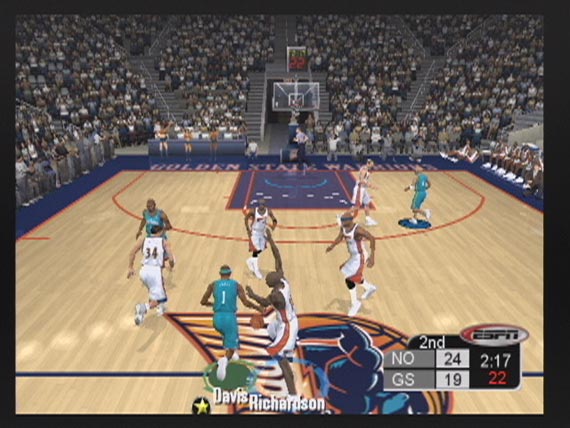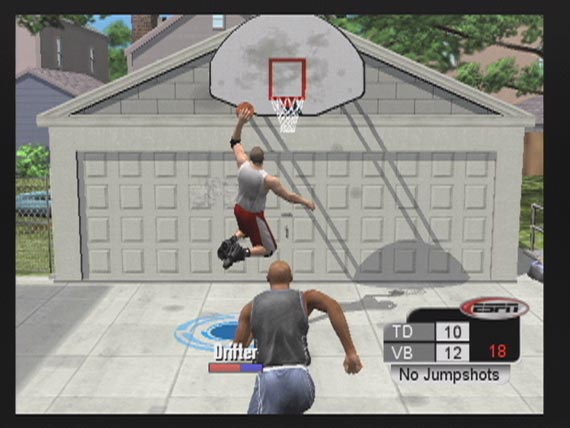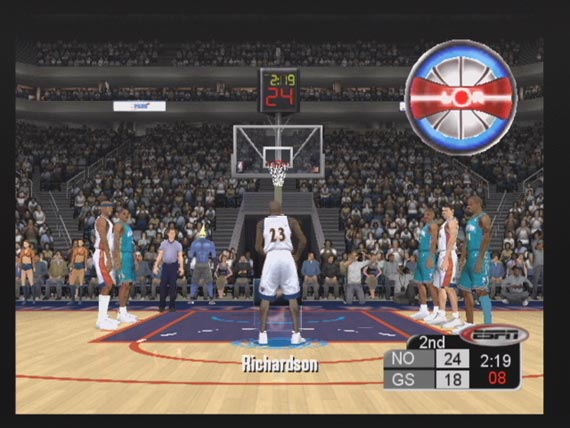


|
Developer: Visual Concepts
Publisher:
Genre:
# of Players:
Rating: |
|
ESPN NBA Basketball By: Ramon Vargas on December 24, 2003 Since Sega released the Dreamcast in September 1999, Visual Concepts has been developing mechanically and graphically superior renditions of the game of basketball with their NBA2k line than EA Sports has with the NBA Live series. This year's entry (dubbed ESPN Basketball, as part of the ESPN Sports line Sega has been publishing this year) brings gamers the NBA to their living rooms with improved and detailed graphics, new or updated game modes (an RPG mode!), and all 29 NBA teams and their arenas (just for good measure, the Charlotte Bobcats are included in anticipation of the 2004-2005 expansion).
Gameplay Players also hire coaching staff, trainers, and scouts. Highly skilled scouts will give you every bit of information necessary to decide which players to draft come draft time. A time limit hinders one’s opportunity to gloss over player information endlessly, so good scouts become important to producing young and skilled players. A trade block lets other teams know that the player is open to negotiation for player personnel—within a few game weeks offers from all over the league will abound. If players decide to simulate the season, the team’s game scheme is still in the player’s hands—board crashing, fast breaks, and outside/inside shots can be determined at the touch of the X button in the appropriate menu. Half court 1-on-1, 2-on-2, right on up to 5-on-5 full court street modes are available, including famous street battlegrounds such as Rucker Park and Venice Beach. A new RPG game mode demands its own section—24/7 mode. Ever owned a Tamagotchi or played Animal Crossing for the Dreamcast? Then you’ve wet your feet as to what this mode requires. This mode allows players to design a street baller from head to toe (name, alma mater, head bands, arm bands, and shoes). Faces, muscle tone, hair style, and tattoos are all customizable. Players take their ballers to training camp, honing basic skills to gain a competitive level. Exercises to increase defense, mid-range and long-range shooting, and lay-ups and dunks are available at the gym. Tasks like hitting 2 mid-range shots in a row without getting blocked get ballers attribute points. My Reinaldo Santana, hailing from University of New Orleans, has an 87 mid-range shot, 84 block, but couldn’t dunk a donut in a coffee cup. Dedication and time is required to create an all around, solid player. Then, one takes his player to the streets, challenging others to 1-on-1 with normal rules, only dunks, or only long-range shots, and with victories players gain items (clothes, head gear, etc) and cell phone numbers. More importantly, ranking points with victories gain players prestige and eligibility to compete in more prestigious tournaments. When you need a partner for 2-on-2 matchups or training exercises that require a partner, dial up one of the numbers in your phone. Courts nationwide (driveway in Seattle, a lobby in Maine, factories, etc) set the backdrop for the matchups. The baller’s goal is to challenge and defeat the international boss characters. Daily maintenance is required—24/7 mode is tied in with your system clock, and certain skills deteriorate if players do not play with their character for long stretches of time. Unlockable courts, new gear to customize your baller with, and online capability also aid in making the 24/7 mode very compelling. On court, the controller scheme may take a while to tack down; but once mastered, it is very accessible and adequate. IsoMotion is Sega’s counter to EA Sports’ Freestyle control; moves executed with the right joystick are used to shake off a defender or sleekly split past double teams to open up shots (it should be reserved for quick and short guards, since big men are clumsy and have poor ball-handling). The play selection on court is limited—tapping the R2 button brings up only a 4 play menu, severely limiting team maneuvers and making the ones available limited. By tapping the triangle button, passing icons designated to the 5 players on court pop appear, allowing players to pass it precisely to the player who has the best shot open. The free throw system is insanely difficult, but players can choose to let the computer take shots from the line. The mechanics on the court are impressive, definitely the best on the market currently. They can be incredulous at times, especially when 6’1 Hornet guard David Wesley beats Shaquille O’Neal or Yao Ming for offensive rebounds (which happened 4 or 5 times in consecutive games when I pitted New Orleans against L.A. and Houston).
Graphics The visuals (scoreboards, stat bars, etc.) are modeled after the "NBA on ESPN's" graphics, seen on primetime Wednesdays and Saturday nights. The set of Sportscenter (the anchor desk, that is) graces the background of the main menu. ESPN’s endorsement works in spades for the game’s presentation, as each game is displayed as if being transmitted on cable television, complete with half-time commentary, cuts to player celebrations, and post-game analysis (while showing shots of players talking on the bench, coaches discussing strategy, etc). sible and adequate. IsoMotion is Sega\rquote s counter to EA Sports\rquote Freestyle control; moves executed with the right joystick are used to shake off a defender or sleekly split past double teams to open up shots (it should be reserved for quick and short guards, since big men are clumsy and have poor ball-handling). The play selection on court is limited\emdash tapping the R2 button brings up only a 4 play menu, severely limiting team maneuvers and making the ones available limited. By tapping the triangle button, passing icons designated to the 5 players on court pop appear, allowing players to pass it precisely to the player who has the best shot open. The free throw system is insanely difficult, but players can choose to let the computer take shots from the line. The mechanics on the court are impressive, definitely the best on the market currently. They can be incredulous at times, especially when 6’1 Hornet guard David Wesley beats Shaquille O’Neal or Yao Ming for offensive rebounds (which happened 4 or 5 times in consecutive games when I pitted New Orleans against L.A. and Houston).
Sound
Bottom Line
|
© Copyright 2003 PlayStation Pro 2.0
|
|


